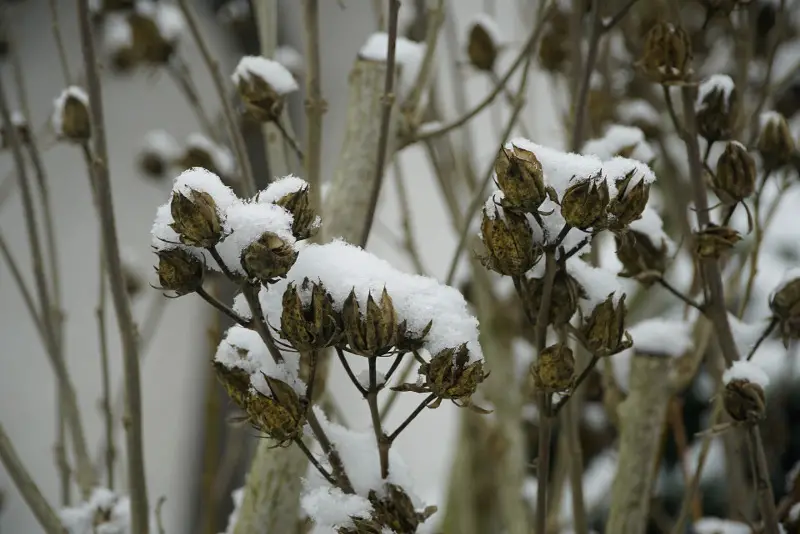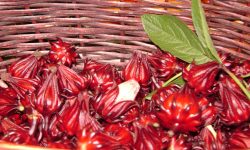When temperatures drop, hibiscus plants face one of their biggest challenges—surviving the winter. These tropical beauties love warmth, sunlight, and moisture, but cold weather can quickly harm their delicate roots and leaves. Many gardeners lose their hibiscus each year simply because they don’t prepare it properly for frost. The good news is that with the right care and timing, you can protect your hibiscus easily and keep it thriving through the cold months.
Learning how to winterize hibiscus correctly helps you preserve its health and beauty until spring returns. Whether you grow tropical or hardy varieties, both need protection from freezing temperatures. With a few careful steps, you can prevent frost damage, reduce stress, and encourage new growth when the weather warms. This guide will show you practical, simple ways to prepare, move, and care for your hibiscus during winter so it stays vibrant and ready to bloom again next season.
Understanding How Cold Affects Hibiscus Plants

Hibiscus plants come from warm, tropical regions where sunlight, warmth, and moisture stay consistent. When temperatures fall below 50°F, their metabolism slows. The leaves begin to curl, fade, or drop, signaling stress from the cold. Frost forms when the temperature dips below freezing, and this can damage the soft tissues within stems and leaves. Tropical hibiscus cannot survive freezing conditions for long, while hardy hibiscus may tolerate light frost for short periods. Prolonged exposure below 32°F damages roots and stops nutrient flow, leading to serious decline.
As the cold sets in, the hibiscus naturally enters dormancy to protect itself. The plant redirects energy from leaf and flower production to root survival. This phase reduces visible growth but is vital for long-term strength. When temperatures drop too low, the roots lose water-absorbing ability, causing dehydration and leaf loss. Frozen soil restricts oxygen movement around the root system, further stressing the plant. Gardeners who understand this cycle can prepare ahead by reducing watering, adjusting sunlight, and insulating roots before frost arrives.
Temperature tolerance also depends on the hibiscus type. Tropical varieties prefer indoor protection once nights fall below 55°F. Hardy types can stay outside longer but still need mulch and wind protection. Cold winds strip moisture from leaves, increasing stress and slowing recovery. By monitoring weather changes closely, you can act early to protect your hibiscus. Understanding how cold affects its structure and energy use helps you take smart steps that prevent frost damage and keep the plant thriving year after year.
Preparing Hibiscus for Winter
Preparing hibiscus for winter should begin well before freezing temperatures arrive. Late fall is the ideal time to start adjusting care routines. As the days shorten and the weather cools, gradually reduce watering. Too much moisture in cold soil harms the roots and slows dormancy. Begin checking the forecast for frost warnings so you can act early. When nights consistently fall near 55°F, it’s time to prepare the plant for protection. Early preparation helps hibiscus transition smoothly into winter and remain healthy for spring regrowth.
Inspect the plant closely before moving it indoors or covering it. Remove dried flowers, weak branches, and damaged leaves to prevent disease. Rinse the foliage gently with lukewarm water to eliminate hidden pests like aphids or whiteflies. Allow the plant to dry completely before bringing it inside. Light pruning helps reduce size and encourages better air circulation. Around the base, apply a two- to three-inch layer of mulch or compost. This natural insulation keeps the soil warm, holds moisture, and shields roots from sudden temperature drops.
If you grow hibiscus in containers, move the pots indoors before the first hard frost. Choose a location with bright, indirect light and stable warmth above 60°F. Keep humidity moderate by misting occasionally, especially in dry homes. For garden hibiscus, add thick mulch or straw around the base and cover the plant with burlap on freezing nights. Avoid fertilizing late in fall since it triggers tender new growth that freezes easily. Thorough preparation ensures your hibiscus survives winter strong, disease-free, and ready to burst into bloom when spring warmth returns.
Bringing Potted Hibiscus Indoors for Winter
As the first signs of frost approach, bringing your potted hibiscus indoors becomes essential. Tropical varieties cannot survive even mild freezes, so timing matters. Move the plant inside when nighttime temperatures drop below 55°F. Choose a bright room with plenty of indirect sunlight, such as a south-facing window. If natural light is limited, use grow lights to keep the plant active. Before bringing the plant indoors, inspect every leaf and stem carefully for pests like aphids or mites. Wash the foliage gently with mild soapy water, rinse with clean water, and allow it to dry fully. This cleaning step prevents insects and disease from spreading inside your home.
Once indoors, create a stable, comfortable environment. Maintain a temperature between 60°F and 75°F and avoid drafts or heating vents. Hibiscus dislikes sudden temperature swings. Keep humidity moderate by misting the leaves every few days or placing a humidifier nearby. The plant still needs moisture, but overwatering leads to root problems. Check the soil often and water only when the top inch feels dry. Good air circulation helps prevent mold or leaf drop. Light pruning removes damaged or weak growth and keeps the plant compact through the winter months.
Indoor hibiscus may slow down or drop leaves during this adjustment phase. This response is normal and temporary. Continue providing steady light, warmth, and light watering. Fertilize lightly once a month with a diluted liquid fertilizer to maintain energy. Avoid heavy feeding, which encourages weak winter growth. As spring approaches, start acclimating the plant by exposing it gradually to outdoor sunlight. With consistent indoor care, your hibiscus remains healthy, strong, and ready to burst into bloom once warm weather returns.
Caring for Outdoor Hibiscus During Winter
Outdoor hibiscus needs extra attention to survive winter safely. Hardy varieties tolerate light frost, but tropical ones are more fragile. Start preparing your outdoor hibiscus when nighttime temperatures dip below 50°F. Gradually reduce watering to slow its growth and help it enter dormancy naturally. Stop fertilizing by early fall, as new shoots won’t survive the cold. Apply a thick layer of mulch, straw, or compost around the base, covering an area about two feet wide. This insulation traps warmth, maintains moisture, and shields the roots from sudden cold snaps. It also helps prevent erosion and keeps weeds from stealing nutrients during the dormant period.
When frost warnings appear, protect the plant before the temperature drops below freezing. Use burlap, frost cloth, or breathable garden fabric to cover the entire plant. Wrap it loosely to allow air circulation and prevent mold buildup. Avoid using plastic sheets, as they trap condensation and cause frost damage to the leaves. In areas with heavy snow or icy winds, support the covering with stakes to prevent it from collapsing. If temperatures fall below 25°F, place a thick layer of leaves or hay around the base for extra insulation. In extremely cold regions, dig up tropical hibiscus and transfer it indoors until spring.
Throughout winter, water sparingly but consistently. Check the soil every week, watering only when it feels dry two inches below the surface. Avoid soaking the soil, which leads to root rot in cold conditions. After snowfalls, gently brush off the accumulation around the base to prevent moisture buildup. When spring warmth returns, uncover the plant slowly to help it adjust to sunlight again. These winter habits protect your hibiscus from frost damage and ensure it revives stronger with fresh growth each spring.
Reviving Hibiscus in Spring
As the days grow longer and temperatures rise, your hibiscus begins to wake from its winter rest. Early spring is the perfect time to revive it and encourage new growth. Start by removing mulch or protective coverings gradually once frost danger has passed. Exposing the plant too quickly can cause shock. When the soil warms above 55°F, new shoots begin to appear along the stems. Cut away any dead or frost-damaged branches to allow energy to focus on healthy growth. This early pruning improves airflow, shape, and flowering potential later in the season.
Next, feed the plant to jumpstart growth. Apply a slow-release or liquid fertilizer high in potassium and nitrogen to support leaf and flower development. Water thoroughly after feeding to help nutrients reach the roots. If your hibiscus spent the winter indoors, start moving it outside slowly. Place it in partial shade for a few hours each day, then increase sunlight exposure over one to two weeks. This hardening process prevents leaf burn and helps the plant adapt to outdoor conditions again. Regular watering keeps the roots active and prevents dehydration during the transition.
Once the hibiscus shows new leaves and buds, resume regular care routines. Prune lightly to shape the plant and remove weak shoots. Check for pests early in the season, as aphids and whiteflies often appear with new growth. Mulch again to protect roots and maintain steady moisture levels. Continue watering deeply once or twice weekly, depending on the weather. By mid-spring, your hibiscus will stand tall, full of fresh foliage, and ready to bloom vibrantly through summer.
Feeding and Pruning After Winter
Once your hibiscus begins growing again in spring, proper feeding and pruning determine how well it recovers and blooms. The first few weeks after dormancy are critical for rebuilding strength. Start feeding the plant once new leaves appear and the temperature stays above 60°F. Use a balanced fertilizer with slightly higher potassium levels to promote flower formation. Apply it every two weeks during the active season, always watering afterward to help nutrients reach the roots. Avoid heavy doses, which can burn tender growth. Gradual feeding restores vitality and prepares the hibiscus for its lush summer display.
Pruning plays an equally important role in post-winter recovery. Early spring pruning removes dead wood and frost-damaged stems that block new growth. Cut above healthy nodes to encourage branching and fuller shape. Use clean, sharp tools to prevent tearing or spreading disease. Pruning also increases airflow, allowing sunlight to reach interior branches. This helps reduce pests and fungal problems that thrive in dense foliage. Light pruning throughout the season keeps the plant balanced and blooming continuously. Removing faded flowers also redirects energy toward producing new buds.
Regular observation ensures your hibiscus stays strong after winter. Monitor new shoots for pests like aphids or mealybugs, which often appear on tender growth. Keep the soil moist but not soggy, as deep watering supports strong root recovery. Combine feeding, pruning, and steady hydration for the best results. By late spring, your hibiscus will burst with healthy leaves and vibrant blooms, ready to fill your garden with tropical color and fragrance once again.
Preventing Frost Damage in the Future
Preventing frost damage starts with understanding how hibiscus reacts to temperature changes. These plants thrive in warmth and struggle when exposed to cold, dry air. Planning ahead before winter arrives makes a big difference. Always track seasonal forecasts and prepare early when temperatures begin to drop below 55°F. If your hibiscus grows in containers, move it indoors before the first frost. Garden plants should receive extra protection through mulch, compost, or natural coverings. Avoid waiting for visible frost because damage often begins before ice appears. Preparation in late autumn ensures your hibiscus stays strong throughout winter.
Site selection also helps prevent future frost stress. Choose a location with good sunlight and natural shelter from cold winds. Areas near walls, fences, or large rocks absorb and radiate heat, keeping the air around your hibiscus slightly warmer. In regions with harsh winters, plant hardy hibiscus varieties that tolerate lower temperatures. For tropical types, consider growing them in pots for easier relocation during cold months. Using frost blankets or cloches during freezing nights adds extra protection and keeps warmth trapped near the plant. Simple, early precautions prevent most cold-related problems.
Long-term care strengthens your hibiscus against future winters. Keep the plant well-fed through summer, as healthy roots resist cold stress better. Avoid overwatering in late fall, since wet soil freezes faster and damages roots. Prune only lightly before winter so stems retain energy reserves. In early spring, remove insulation gradually to prevent shock. With consistent preparation and seasonal care, your hibiscus adapts better each year. Protecting it from frost becomes easier once the plant grows stronger, producing more blooms and lasting longer season after season.
Common Mistakes When Winterizing Hibiscus
Bringing the Plant Indoors Too Late
One of the most common mistakes gardeners make is moving their hibiscus indoors too late. Many believe the plant can handle a few cold nights, but tropical varieties begin suffering once temperatures drop below 50°F. Even light frost damages the leaves and weakens the root system. Once the damage starts, the plant struggles to recover during dormancy. The best time to bring hibiscus inside is when nights remain cool but not yet freezing. Early preparation gives the plant time to adjust gradually to its new environment, avoiding sudden temperature shocks that cause leaf drop.
Before moving the hibiscus indoors, inspect the leaves and stems carefully. Remove old flowers, weak branches, and any pests hiding under the foliage. Wash the plant gently with warm, soapy water and let it dry completely. Place it outdoors in the shade for a few days before moving it inside to help it adapt to lower light levels. Once indoors, position it near a sunny window and maintain warmth between 65°F and 75°F. Moving the plant before frost arrives ensures healthy roots and smooth adjustment, allowing your hibiscus to stay green and lively all winter.
Overwatering During the Dormant Period
Overwatering is a silent killer during the hibiscus dormant phase. Many gardeners continue watering as if it were summer, not realizing that growth slows dramatically in winter. The plant’s water use decreases as it enters rest mode. Excess moisture fills the air pockets in the soil and suffocates roots. This leads to root rot, yellowing leaves, and eventually plant death. Always test the top inch of soil before watering. If it still feels moist, wait a few days longer. The soil should feel slightly dry before you water again.
Use containers with excellent drainage so water never sits around the roots. Empty saucers after watering to avoid stagnant water buildup. Indoors, evaporation slows, so hibiscus may only need watering every ten days. Use lukewarm water to avoid shocking the roots. When the plant receives balanced moisture, it rests comfortably through winter without rotting. As days lengthen in spring, you can slowly increase watering again. Managing moisture carefully helps your hibiscus conserve energy during dormancy and recover quickly once growth resumes.
Pruning Too Early or Too Much
Pruning at the wrong time can seriously weaken hibiscus before winter. Heavy pruning in late fall removes energy reserves stored in the stems and leaves. These nutrients keep the plant alive during cold months. The best approach is light pruning to remove damaged or diseased growth, leaving the rest untouched. Wait until early spring for major trimming, when new buds begin forming. This timing ensures that the plant uses its stored energy efficiently. Premature pruning often causes shock, slows recovery, and increases vulnerability to frost injury.
If you must prune before winter, make sure to sterilize tools to prevent infection. Seal large cuts with tree balm or natural wax to reduce moisture loss. Avoid pruning after fertilizing since new shoots that appear afterward will freeze easily. Instead, mulch around the base to insulate roots and lower stems. Light pruning keeps the plant strong and balanced while conserving nutrients. When warmer weather returns, your hibiscus will reward you with fuller, healthier growth and more vibrant flowers.
Ignoring Pests Before Bringing Indoors
Failing to check for pests before moving hibiscus indoors is one of the easiest mistakes to make. Insects like aphids, spider mites, and whiteflies thrive on hibiscus leaves, especially in mild autumn weather. When brought inside, these pests multiply quickly in the warm, stable indoor climate. They damage leaves, spread disease, and stress the plant during dormancy. Always inspect both sides of the leaves carefully before relocation. Wipe them with a damp cloth or spray with mild soapy water. This step removes insects, eggs, and dust that block sunlight.
Allow the plant to dry completely before bringing it indoors. After moving it, place the hibiscus in quarantine for about a week away from other plants. Check the undersides of leaves daily for pests that may have been missed. If necessary, apply neem oil or insecticidal soap. Keep air circulation steady and humidity moderate, since stagnant air encourages pest buildup. Ignoring these steps leads to infestations that stunt growth and weaken the plant over winter. Taking extra time to clean and monitor your hibiscus ensures it stays healthy and pest-free until spring returns.
Monitoring Hibiscus Health Throughout Winter
Once your hibiscus settles into its winter environment, regular monitoring becomes the key to survival. Indoor plants, though protected from frost, still face challenges such as dry air, pests, and overwatering. Check your hibiscus every few days for signs of stress. Yellow leaves may indicate too much water or too little light. Curling leaves often mean the air is too dry. Maintain a stable temperature between 60°F and 75°F and avoid sudden drafts. Use a humidifier or misting bottle to maintain proper humidity. Consistency keeps the plant healthy even during long, dark winter weeks.
For outdoor hibiscus, check the mulch regularly to ensure it stays dry and thick enough to insulate the roots. After heavy rain or snow, refresh the mulch layer to prevent it from compacting. Inspect the stems occasionally for frost cracks or animal damage. If you notice wilting after a freeze, prune lightly to remove damaged tips and stop decay. Always keep soil slightly moist but never soggy to prevent rot.
Observation helps you respond early to small issues before they become serious. If mold forms on the soil surface, remove it immediately and improve airflow. For indoor plants, rotate the pot weekly for even light exposure. A few minutes of consistent care each week prevents major winter problems. Steady monitoring ensures your hibiscus stays resilient, balanced, and ready for spring growth when warm weather returns.
Transitioning Hibiscus Back Outdoors in Spring
As spring arrives, your hibiscus will be eager to return outdoors. However, moving it too quickly from indoor warmth to outdoor conditions can shock the plant. Wait until night temperatures stay above 60°F before starting the transition. Begin by placing the plant outside in partial shade for a few hours daily. Gradually increase sun exposure over one to two weeks. This process, called hardening off, helps the leaves adapt to natural sunlight and prevents sunburn. Gentle transitions reduce stress and encourage strong, healthy growth once the plant returns fully outdoors.
Check the roots before replanting outdoor hibiscus. If they appear crowded or tangled, trim them slightly and refresh the soil mix. Use nutrient-rich, well-draining soil to promote new root growth. Water thoroughly after replanting to help the plant settle. For the first week, protect it from strong winds or heavy rain while it adjusts. Add a light layer of compost around the base to feed the roots gradually.
Continue watching for early pests like aphids and mites, which often appear as temperatures rise. Resume regular feeding every two weeks with a balanced fertilizer to boost foliage and blooms. Keep watering consistent as the plant begins active growth again. Within a few weeks, your hibiscus will respond with lush green leaves and vibrant flowers. Proper transition care after winter ensures a thriving, beautiful hibiscus ready to brighten your garden through the warmer months.
FAQs About Winterizing Hibiscus
When should I start winterizing my hibiscus?
Begin winterizing your hibiscus when nighttime temperatures drop below 55°F. Start reducing watering and stop fertilizing at this time. Move potted tropical varieties indoors before the first frost. Early preparation allows the plant to adjust gradually, preventing shock and keeping it healthy through cold months.
Can I keep my hibiscus outside all winter?
Only hardy hibiscus can stay outdoors during winter. Tropical types must be brought indoors or heavily protected. For hardy varieties, add mulch around the base to insulate roots. In regions with severe frost, cover the plant with burlap or frost cloth to prevent cold damage and ensure spring regrowth.
How often should I water hibiscus during winter?
Water sparingly during winter since hibiscus slows growth in cold conditions. Check soil moisture weekly and water only when the top inch feels dry. Avoid soaking the roots, as cold, wet soil causes rot. Keep indoor humidity moderate with misting or a small humidifier to prevent leaf drop.
Do hibiscus plants need fertilizer in winter?
No, hibiscus doesn’t need fertilizer during its dormant period. Feeding during winter encourages weak, soft growth that can’t handle the cold. Wait until new shoots appear in early spring before resuming fertilization. This timing supports healthy root recovery and strong flower production once temperatures rise again.
Why are my indoor hibiscus leaves turning yellow in winter?
Yellow leaves usually mean too much water, low humidity, or insufficient light. Move your plant closer to a bright window and reduce watering frequency. Maintain humidity by misting leaves every few days. If leaves continue dropping, check for pests or root rot and adjust care accordingly.
Conclusion
Winterizing hibiscus may seem challenging, but with care and preparation, it becomes a simple routine. Protecting your plant before frost ensures its survival and strong spring revival. Every small effort—moving it indoors, adjusting water, or adding mulch—makes a big difference. Consistent observation helps prevent stress and keeps roots healthy. As temperatures rise, your hibiscus rewards you with bright foliage and radiant blooms. Winter care is not just protection; it’s an investment in lasting beauty. With patience and proper attention, your hibiscus thrives year after year, bringing tropical color and life back to your garden.






